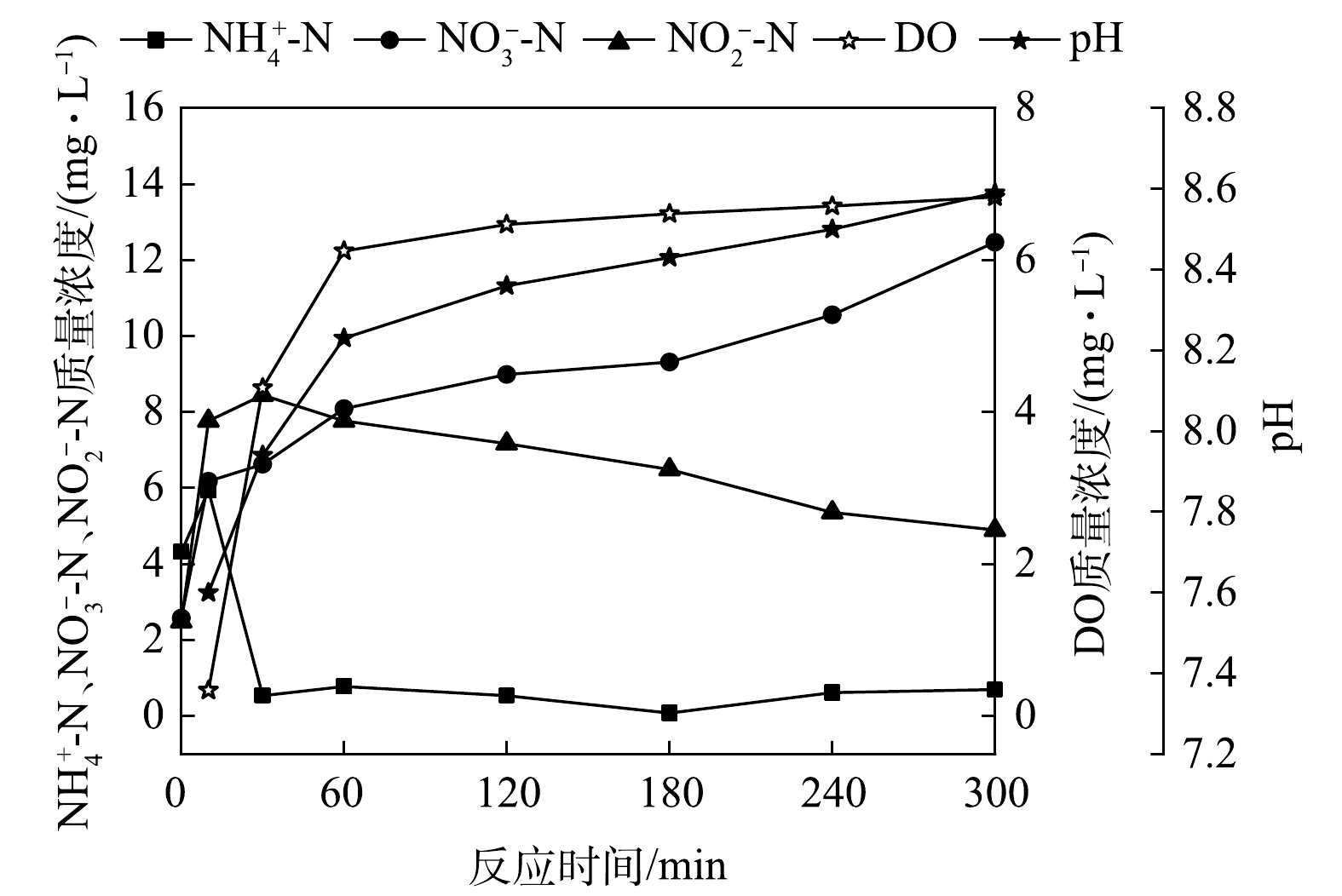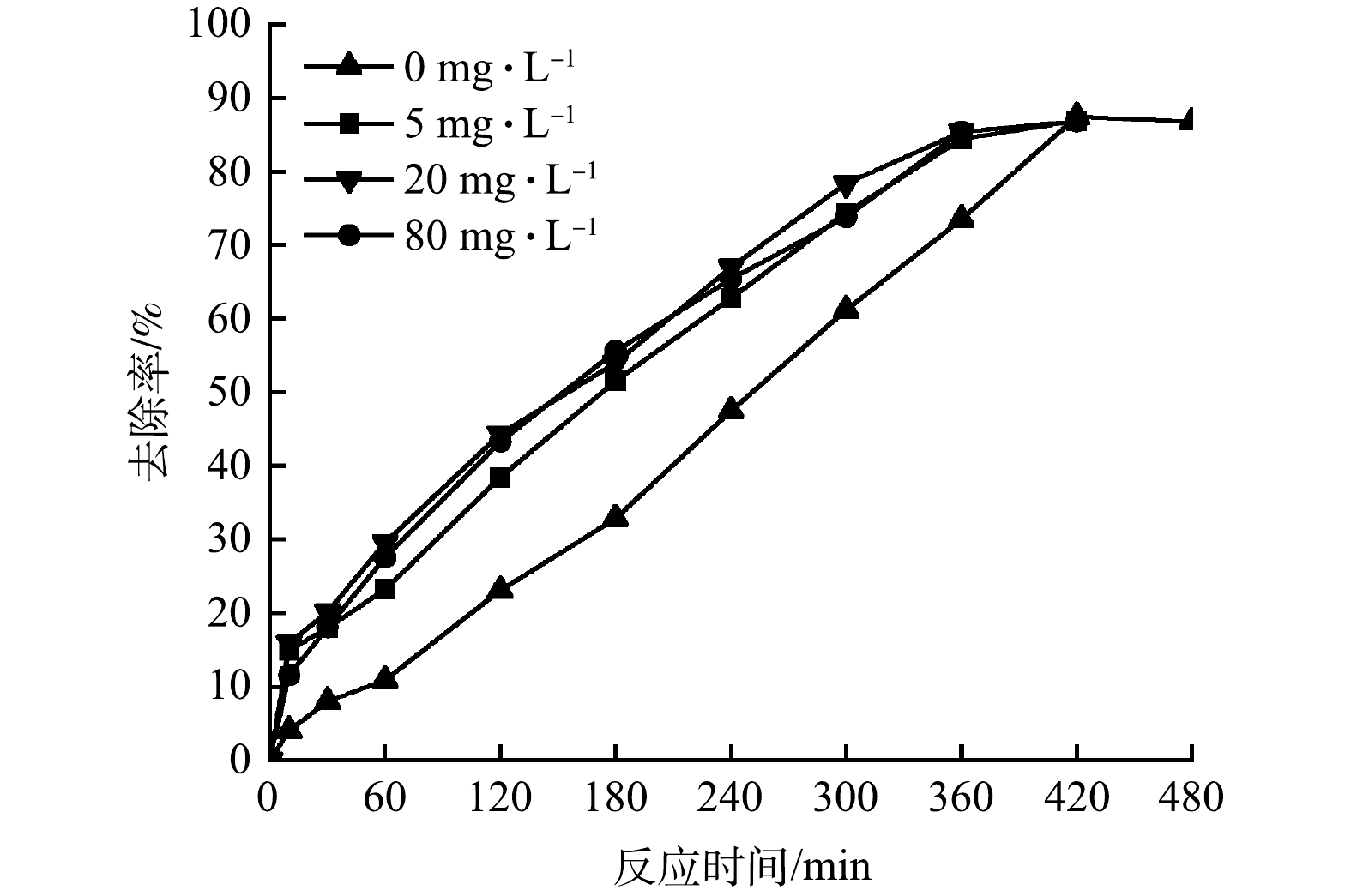-
CANON工艺是以厌氧氨氧化技术(anaerobic ammonium oxidation,ANAMMOX)为基础,以亚硝酸盐氮(
${\rm{NO}}_2^ - $ -N)为电子受体,将${\rm{NH}}_4^ + $ -N转化为N2的一种新型脱氮工艺[1],具有不需要有机物,节省曝气量和污泥产量少的优势[2]。该工艺的核心是控制反应条件以实现短程硝化。氨氧化细菌(ammonia oxidizing bacteria,AOB)亚硝酸化反应过程如图1所示。NH2OH是其中重要的中间产物[3],具有调节硝化细菌中酶合成过程以及酶活性的作用[4]。首先,进水中${\rm{NH}}_4^ + $ -N在氨单加氧酶(ammonia mono-oxygenase,AMO)的作用下被氧化成NH2OH;随后,在羟胺氧化还原酶(hydroxylamine oxidoreductase,HAO)的催化作用下,NH2OH被氧化成${\rm{NO}}_2^ - $ -N,而从NH2OH到${\rm{NO}}_2^ - $ -N转化过程中释放4个电子,其中2个电子用以末端氧化酶呼吸,另外2个电子转移到AMO上进一步氧化${\rm{NH}}_4^ + $ -N[5]。目前,一些研究者主要针对添加NH2OH促进短程硝化的可行性进行研究。陈佼等[4]通过连续13 d向人工快渗系统中添加16.5 mg·L−1 NH2OH后,实现了短程硝化的快速启动,${\rm{NH}}_4^ + $ -N去除率和${\rm{NO}}_2^ - $ -N积累率分别为91.1%和77.9%。XU等[6]通过向好氧颗粒污泥中添加10 mg·L−1 NH2OH成功实现了稳定的短程硝化,且通过荧光原位杂交技术(fluorescence in situ hybridization, FISH)证明了反应器中大部分NOB被淘洗掉,AOB成为主要的优势菌群。应用CANON工艺,有多种形式的反应器,MBBR是常见3种形式之一[7],其内部生物填料长期保持流化状态。因此,能够在与污水介质充分接触的同时大量富集微生物[8],同时,具有耐冲击负荷、污泥产量较低、污泥沉降性能好[9]以及不需要频繁反冲洗等特点[10]。目前,关于NH2OH对于CANON工艺的影响研究较少,为探究NH2OH对CANON工艺中短程硝化及脱氮性能的影响,本研究利用运行稳定的MBBR进行批次实验,在反应初期添加不同质量浓度的NH2OH,探索了NH2OH对MBBR中CANON工艺的影响机理,以期为实现CANON技术的工程化应用提供参考。
全文HTML
-
实验装置采用课题组已稳定运行40 d的MBBR,反应器由有机玻璃制成,有效容积为7 L,装置参见文献中的装置图[11]。反应器内含生物膜填料2.5 L,填充比例为35 %。填料为改性聚乙烯材质,呈圆柱形状,高为8 mm,直径为10 mm,密度约为0.96 g·cm−3,圆柱内部有圆形支撑,侧边沿不同径向伸展尾翅以增加填料的表面积。
-
实验采用人工模拟的无机高
${\rm{NH}}_4^ + $ -N废水为进水,自反应器下端进入,出水从上端排出。即向自来水中投加一定量的NH4Cl、NaHCO3 (提供${\rm{HCO}}_3^ - $ )、KH2PO4和1 mL·L−1微量元素浓缩液Ⅰ和1 mL·L−1微量元素浓缩液Ⅱ。其中微量元素浓缩液具体配方参见文献中的方法[12]。具体进水水质为230 mg·L−1${\rm{NH}}_4^ + $ -N、0~10 mg·L−1${\rm{NO}}_2^ - $ -N、0~10 mg·L−1${\rm{NO}}_3^ - $ -N、10 mg·L−1${\rm{PO}}_4^{3 - }$ -P、约1 500 mg·L−1 碱度(以CaCO3计),控制进水pH在7.43~7.74。 -
反应器为实验室稳定运行40 d的CANON反应器,日常运行时,TN去除率为(74.3±14.7)%,TN去除负荷为(1.32±0.27) kg·(m3·d)−1。实验采用恒温加热棒将水浴温度维持在(30±1) ℃,调整进水pH约7.5,搅拌转速为80 r·min−1,采用连续曝气,曝气速率为1 500 mL·min−1。选用盐酸羟胺(NH2OH·HCl)提供实验所需的NH2OH,基于化学计算投加相应的NH2OH质量浓度。前4组(A、B、C、D)进水中同时包括
${\rm{NH}}_4^ + $ -N和NH2OH,分别控制初始NH2OH质量浓度为0、5、20、80 mg·L−1。E组进水中仅包括NH2OH,且NH2OH质量浓度与D组相同,以作为D组的对照,具体参数如表1所示。在实验开始前,为了排除反应器中原本存在的各项含氮物质的干扰,将反应器中的污泥清洗3遍。为了减轻清洗污泥对微生物群落产生的影响,在操作过程中尽量避免大幅度的清洗动作,以减少干扰。在实验过程中,由于反应初期
${\rm{NH}}_4^ + $ -N质量浓度较高,能够提供足够的反应底物,反应速率较快,因此,实验在第1 h内分别在反应开始后的0、10、30和60 min时分别取水样(用以检测${\rm{NH}}_4^ + $ -N、${\rm{NO}}_2^ - $ -N及${\rm{NO}}_3^ - $ -N),并同步检测反应器的pH和溶解氧(dissolved oxygen, DO);此后,每次间隔1 h监测水样,直至运行周期结束。每周期结束以后,恢复MBBR的运行工况至正常状态,即采用连续进水,进水中不添加NH2OH,${\rm{NH}}_4^ + $ -N质量浓度为400 mg·L−1,其他条件与本实验一致,以调节微生物活性。 -
本实验中各污染物的检测指标均参考《水和废水监测分析方法》[13]进行。常规指标及检测方法为:
${\rm{NO}}_3^ - $ -N采用紫外分光光度法;${\rm{NH}}_4^ + $ -N采用纳氏试剂比色法;${\rm{NO}}_2^ - $ -N采用N-(1-萘基)-乙二铵光度法;pH采用pH计(梅特勒-托利多,瑞士)进行测量;DO采用Multi 350i溶解氧仪(WTW,德国)测量。TN质量浓度按照式(1)进行计算。式中:
$ {C}_{{\mathrm{N}\mathrm{H}}_{4}^{+}{\text{-}}\mathrm{N}} $ 为${\rm{NH}}_4^ + $ -N质量浓度,mg·L−1;$ {C}_{{\mathrm{N}\mathrm{O}}_{3}^{-}{\text{-}}\mathrm{N}} $ 为${\rm{NO}}_3^ - $ -N质量浓度,mg·L−1;$ {C}_{{\mathrm{N}\mathrm{O}}_{2}^{-}{\text{-}}\mathrm{N}} $ 为${\rm{NO}}_2^ - $ -N质量浓度,mg·L−1。
1.1. 实验装置
1.2. 实验用水
1.3. 实验方法
1.4. 检测及分析方法
-
在添加不同质量浓度NH2OH的4组MBBR中,不同含氮物质、pH和DO随时间的变化情况如图2所示。可以看出,A、B、C和D组反应的各项水质指标变化规律基本一致。以A组为例,当不投加任何NH2OH时,随着反应的进行,
${\rm{NH}}_4^ + $ -N质量浓度逐渐降低,在420 min降至0 mg·L−1。${\rm{NO}}_3^ - $ -N的质量浓度随时间逐渐升高至25.6 mg·L−1。${\rm{NO}}_2^ - $ -N在${\rm{NH}}_4^ + $ -N降为0 mg·L−1之前逐渐上升至7.62 mg·L−1,随后略微下降。这是由于${\rm{NO}}_2^ - $ -N是CANON反应的中间产物,当${\rm{NH}}_4^ + $ -N质量浓度充足时,${\rm{NH}}_4^ + $ -N转化为${\rm{NO}}_2^ - $ -N的速率超过${\rm{NO}}_2^ - $ -N转化为${\rm{NO}}_3^ - $ -N的速率,造成${\rm{NO}}_2^ - $ -N质量浓度逐渐增加。${\rm{NH}}_4^ + $ -N质量浓度不足后,${\rm{NH}}_4^ + $ -N氧化为${\rm{NO}}_2^ - $ -N的速率降低,逐渐低于${\rm{NO}}_2^ - $ -N氧化为${\rm{NO}}_3^ - $ -N的速率,因此,初期积累的${\rm{NO}}_2^ - $ -N被消耗,导致其质量浓度开始降低。pH呈现先略微升高又快速降低的趋势,待
${\rm{NH}}_4^ + $ -N消耗基本完毕后,pH快速上升,在此处有一个明显的拐点,在拐点前,DO基本小于0.15 mg·L−1,并且变化不大;在拐点后,DO快速上升至5 mg·L−1以上。pH和DO的拐点变化规律与张杰等[14]的研究结果一致。对比4组反应可以看出,DO和pH分别在420、360、300和360 min发生突变,此时${\rm{NH}}_4^ + $ -N基本消耗殆尽,结合pH和DO的变化可知,此时反应已结束或已接近反应终点。对于仅添加80 mg·L−1的NH2OH的E组反应器,含氮物质、pH和DO随运行时间的变化情况如图3所示。可以看出,
${\rm{NH}}_4^ + $ -N在反应开始前30 min内呈现先上升后下降的趋势,随后基本稳定在0.5 mg·L−1左右。${\rm{NO}}_2^ - $ -N在前30 min内上升至8.45 mg·L−1,随后缓慢降低至4.90 mg·L−1。${\rm{NO}}_3^ - $ -N在前10 min内由2.58 mg·L−1快速上升至6.18 mg·L−1,随后缓慢上升,300 min时达到12.47 mg·L−1。分析反应过程为,在反应开始后首先生成了少量${\rm{NH}}_4^ + $ -N,随后在AOB的作用下${\rm{NH}}_4^ + $ -N迅速被转化成${\rm{NO}}_2^ - $ -N,而微量的${\rm{NO}}_2^ - $ -N在ANAMMOX菌和NOB的竞争下显然被迅速利用,导致了${\rm{NO}}_3^ - $ -N的缓慢上升。pH和DO均在开始前30 min内迅速上升,随后缓慢上升,最终分别到达8.59 mg·L−1和6.83 mg·L−1。并且在E组实验中,由于反应器内部仅添加80 mg·L−1的NH2OH而不添加${\rm{NH}}_4^ + $ -N,随着反应的不断进行,在水溶液中显酸性的NH2OH逐渐被消耗,同时由于曝气带来的吹脱作用,使得E组中的pH值随运行时间缓慢升高。 -
由图3可知,尽管没有投加
${\rm{NH}}_4^ + $ -N,但在加入NH2OH后,依然有一部分${\rm{NH}}_4^ + $ -N被测出。这说明在系统中添加的NH2OH会转化为${\rm{NH}}_4^ + $ -N,此后产生的${\rm{NH}}_4^ + $ -N又重新被AOB利用。结合图2可以发现,尽管投加的${\rm{NH}}_4^ + $ -N质量浓度相同,但实际初始${\rm{NH}}_4^ + $ -N质量浓度有较大的差异,且随着NH2OH质量浓度的增加而显著增加。其原因为,NH2OH可能会在ANAMMOX菌的作用下发生歧化反应生成N2和${\rm{NH}}_4^ + $ -N[15]。研究人员[16]发现,在缺乏${\rm{NO}}_2^ - $ -N作为电子受体的情况下,NH2OH会通过ANAMMOX菌发生歧化反应生成${\rm{NH}}_4^ + $ -N和N2,推测其反应方程如式(2)所示。而歧化反应所生成${\rm{NH}}_4^ + $ -N质量浓度与ANAMMOX菌的数量及其活性有关,同时系统内的pH也会对其产生影响。但由图2可见,随着NH2OH质量浓度的增加,歧化反应所生成${\rm{NH}}_4^ + $ -N质量浓度也随之增加。 -
实验中,随着NH2OH质量浓度的提高,初始状态下反应器进水的pH略有降低,分别为7.76、7.74、7.67及7.43。这是因为NH2OH·HCl在水溶液中为酸性,如式(3)所示。而短程硝化的反应方程如式(4)所示,因此,pH的降低将不利于方程式向右进行,即越不利于短程硝化反应。
而事实上,通过表1和图2可以发现,A、B、C和D 4组实验的反应结束时间不同,分别为420、360、300和360 min。可以看出,在添加NH2OH后,
${\rm{NH}}_4^ + $ -N降解速率显著增加。这说明,由于增加NH2OH导致的pH降低对于短程硝化的负面影响不起主要作用,NH2OH的促进作用更为明显。不同NH2OH质量浓度下反应器的${\rm{NH}}_4^ + $ -N降解速率和脱氮性能如表2所示。当NH2OH质量浓度≤20 mg·L−1时,${\rm{NH}}_4^ + $ -N的降解速率随着所添加NH2OH质量浓度的增加而增大。在NH2OH质量浓度为20 mg·L−1的C组中,提高了29.4 %的${\rm{NH}}_4^ + $ -N降解速率,而继续增加NH2OH投加量对于${\rm{NH}}_4^ + $ -N降解速率没有更明显的效果。KINDAICHI等[17]在探讨NH2OH在硝化系统所起作用的过程中也发现,在添加了8.25 mg·L−1NH2OH的系统中,${\rm{NH}}_4^ + $ -N的降解速率是不添加NH2OH时的2倍,这与本研究结果类似。但本研究结果表明,${\rm{NH}}_4^ + $ -N降解速率的提高幅度并不高,可能是因为本实验采用的${\rm{NH}}_4^ + $ -N较为充足,自发产生的NH2OH并不过分缺乏,导致了这种差异。${\rm{NH}}_4^ + $ -N降解速率得以提升的理论原因在于:NH2OH在被氧化为${\rm{NO}}_2^ - $ -N的过程中会产生2对电子,其中1对电子作用于AMO,用于继续将更多的${\rm{NH}}_4^ + $ -N氧化成NH2OH[18](图1);而所添加的NH2OH而一步激活了HAO的活性,进而又激活了AMO的活性,从而加速了${\rm{NH}}_4^ + $ -N的降解速率,促进了短程硝化[19];而加入80 mg·L−1 NH2OH后,${\rm{NH}}_4^ + $ -N降解速率反而降低。其原因为,高质量浓度的NH2OH会对AMO和HAO产性毒性。有研究[20]表明,NH2OH会影响蛋白质的合成,从而抑制了AMO和HAO的活性[4]。在CANON工艺中,短程硝化的效果可以通过∆
${\rm{NO}}_3^ - $ -N/∆TN进行判定[21]。由表2可以看出,添加NH2OH后,4组实验的∆${\rm{NO}}_3^ - $ -N/∆TN比值均低于理论值0.127,且随着NH2OH质量浓度的增加逐渐变小。这说明短程硝化效果变好,NH2OH质量浓度越高,越有利于CANON工艺中NOB的抑制。由图2和图3可知,随着NH2OH质量浓度的增加,${\rm{NO}}_2^ - $ -N质量浓度在周期内部的平均水平存在上升趋势,最高分别为5.89、7.13、7.37和8.02 mg·L−1。这说明NH2OH的添加促使反应器中产生了更多的${\rm{NO}}_2^ - $ -N,在总氮去除效果基本稳定的前提下,促进了系统内的短程硝化过程。乔昕等[22]投加3 mg·L−1和5 mg·L−1的NH2OH可以实现一定量的${\rm{NO}}_2^ - $ -N积累。WANG等[23]的研究结果表明,维持NH2OH质量浓度为5 mg·L−1,可提升短程硝化过程,这与本研究的结果一致。NH2OH促进短程硝化的原因在于,NH2OH的存在会对NOB产生抑制作用[24-26],从而减少了
${\rm{NO}}_2^ - $ -N直接转化为${\rm{NO}}_3^ - $ -N的量,表现为∆${\rm{NO}}_3^ - $ -N/∆TN的逐渐降低。WANG等[18]通过添加20 mg·L−1的NH2OH并配合SRT的调节可将出水${\rm{NO}}_3^ - $ -N从548.4 mg·L−1降至65.1 mg·L−1,发现在自养硝化生物膜系统中加入低质量浓度NH2OH能够不可逆地抑制NOB的生长。YANG等[27]发现,NH2OH具有穿透NOB细胞膜的能力,因此,NH2OH可对NOB的活性产生抑制作用。 -
A~D组反应器中TN去除率变化结果如图4所示。4组实验中TN去除率均逐渐上升。其中未添加NH2OH的A组去除率匀速上升,420 min反应结束到达最值;而添加NH2OH的B、C和D组中TN去除率于前10 min先是快速上升,后匀速上升,360 min时基本均达到最大去除率。
根据图2~4并结合表2,伴随A、B、C和D组实验中NH2OH质量浓度的增加,从去除率角度来看,添加NH2OH的B、C和D组到达最大TN去除率的时间明显快于未添加NH2OH的A组,说明NH2OH的添加会提高反应器整体的脱氮性能。但达到最大去除率所需时间并没有随着NH2OH质量浓度的继续增加而显著减少。总体来看,CANON工艺中的TN去除负荷不断提高,分别为0.71、0.75、0.77和0.84 kg·(m3·d)−1,这与NH2OH投加导致
${\rm{NH}}_4^ + $ -N质量浓度增加有关。尽管在NH2OH质量浓度增加后,反应器中${\rm{NO}}_2^ - $ -N质量浓度也随之增加,但增加幅度较小,对于投加不同质量浓度NH2OH下的脱氮效果,并未造成显著区别,这说明投加5 mg·L−1的NH2OH已经足够,不宜继续增加。事实上,许多研究[28-29]证明了NH2OH的存在确能改善ANAMMOX菌的活性。TIAN等[30]发现,当生物滤池的去除能力不足时,投加3.3 mg·L−1的NH2OH可以提高ANAMMOX的脱氮性能。由于在本研究中仅进行了冲击实验,关于增加NH2OH质量浓度的长期影响,还有待于进一步的研究。
2.1.
NH2OH对初始${\rm{NH}}_4^ + $ -N质量浓度的影响
2.2. NH2OH对短程硝化的影响
2.3. NH2OH对脱氮性能的影响
-
1) NH2OH质量浓度越高,越有利于对CANON工艺中NOB的抑制。
2)当NH2OH质量浓度≤20 mg·L−1时,提高NH2OH质量浓度,有利于提高
${\rm{NH}}_4^ + $ -N降解速率;当NH2OH质量浓度等于5 mg·L−1时,${\rm{NH}}_4^ + $ -N降解速率可以提高16.6 %;当NH2OH质量浓度为20 mg·L−1,${\rm{NH}}_4^ + $ -N降解速率可以提高29.4 %。3)从总体脱氮效果来看,投加NH2OH后,TN去除速率会有所提升,但在不同NH2OH质量浓度下其区别不大,建议投加5 mg·L−1 NH2OH。











 下载:
下载:

















































































































